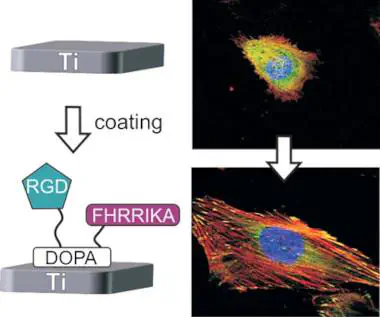Multifunctional Coating Improves Cell Adhesion on Titanium by using Cooperatively Acting Peptides
 Graphical Abstract: Wiley
Graphical Abstract: WileyAbstract
Promotion of cell adhesion on biomaterials is crucial for the long-term success of a titanium implant. Herein a novel concept is highlighted combining very stable and affine titanium surface adhesive properties with specific cell binding moieties in one molecule. A peptide containing L-3,4-dihydroxyphenylalanine was synthesized and affinity to titanium was investigated. Modification with a cyclic RGD peptide and a heparin binding peptide (HBP) was realized by an efficient on-resin combination of Diels–Alder reaction with inverse electron demand and CuI catalyzed azide–alkyne cycloaddition. The peptide was fluorescently labeled by thiol Michael addition. Conjugating the cyclic RGD and HBP in one peptide gave improved spreading, proliferation, viability, and the formation of well-developed actin cytoskeleton and focal contacts of osteoblast-like cells.